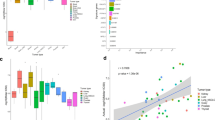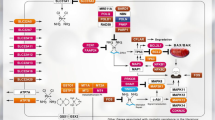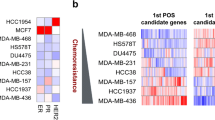Abstract
The goal of this study was to develop pharmacogenomic predictors in response to standard chemotherapy drugs in breast cancer cell lines and test their predictive value in patients who received treatment with the same drugs. Nineteen human breast cancer cell lines were tested for sensitivity to paclitaxel (T), 5-fluorouracil (F), doxorubicin (A) and cyclophosphamide (C) in vitro. Baseline gene expression data were obtained for each cell line with Affymetrix U133A gene chips, and multigene predictors of sensitivity were derived for each drug separately. These predictors were applied individually and in combination to human gene expression data generated with the same Affymetrix platform from fine needle aspiration specimens of 133 stage I-III breast cancers. Tumor samples were obtained at baseline, and each patient received 6 months of preoperative TFAC chemotherapy followed by surgery. Cell line-derived prediction results were correlated with the observed pathologic response to chemotherapy. Statistically robust differentially expressed genes between sensitive and resistant cells could only be found for paclitaxel. False discovery rates associated with the informative genes were high for all other drugs. For each drug, the top 100 differentially expressed genes were combined into a drug-specific response predictor. When these cell line-based predictors were applied to patient data, there was no significant correlation between observed response and predicted response either for individual drug predictors or combined predictions. Cell line-derived predictors of response to four commonly used chemotherapy drugs did not predict response accurately in patients.


Similar content being viewed by others
References
Pusztai L, Anderson K, Hess KR (2007) Pharmacogenomic predictor discovery in phase II clinical trials for breast cancer. Clin Cancer Res 13:6080–6086
Potti A, Dressman HK, Bild A, Riedel RF, Chan G, Sayer R, Cragun J, Cottrill H, Kelley MJ, Petersen R, Harpole D, Marks J, Berchuck A, Ginsburg GS, Febbo P, Lancaster J, Nevins JR (2006) Genomic signatures to guide the use of chemotherapeutics. Nat Med 12:1294–1300
Bonnefoi H, Potti A, Delorenzi M, Mauriac L, Campone M, Tubiana-Hulin M, Petit T, Rouanet P, Jassem J, Blot E, Becette V, Farmer P, André S, Acharya CR, Mukherjee S, Cameron D, Bergh J, Nevins JR, Iggo RD (2007) Validation of gene signatures that predict the response of breast cancer to neoadjuvant chemotherapy: a substudy of the EORTC 10994/BIG 00–01 clinical trial. Lancet Oncol 8:1071–1078
Hsu DS, Balakumaran BS, Acharya CR, Vlahovic V, Walters KS, Garman K, Anders C, Riedel RF, Lancaster J, Harpole D, Dressman HK, Nevins JR, Febbo PG, Potti A (2007) Pharmacogenomic strategies provide a rational approach to the treatment of cisplatin-resistant patients with advanced cancer. J Clin Oncol 25:4350–4357
Coombes KR, Wang J, Baggerly KA (2007) Microarrays: retracing steps. Nat Med 13:1276–1277
Baggerly KA, Coombes KR, Neeley ES (2008) Run batch effects potentially compromise the usefulness of genomic signatures for ovarian cancer. J Clin Oncol 26:1186–1187
Symmans WF, Ayers M, Clark EA, Stec J, Hess KR, Sneige N, Buchholz TA, Krishnamurthy S, Ibrahim NK, Buzdar AU, Theriault RL, Rosales MF, Thomas ES, Gwyn KM, Green MC, Syed AR, Hortobagyi GN, Pusztai L (2003) Total RNA yield and microarray gene expression profiles from fine-needle aspiration biopsy and core-needle biopsy samples of breast carcinoma. Cancer 97:2960–2971
Hess KR, Anderson K, Symmans WF, Valero V, Ibrahim N, Mejia JA, Booser D, Theriault RL, Buzdar AU, Dempsey PJ, Rouzier R, Sneige N, Ross JS, Vidaurre T, Gómez HL, Hortobagyi GN, Pusztai L (2006) Pharmacogenomic predictor of sensitivity to preoperative chemotherapy with paclitaxel and fluorouracil, doxorubicin, and cyclophosphamide in breast cancer. J Clin Oncol 24:4236–4244
Symmans WF, Peintinger F, Hatzis C, Rajan R, Kuerer H, Valero V, Assad L, Poniecka A, Hennessy B, Green M, Buzdar AU, Singletary SE, Hortobagyi GN, Pusztai L (2007) Measurement of residual breast cancer burden to predict survival after neoadjuvant chemotherapy. J Clin Oncol 25:4414–4422
Malich G, Markovic B, Winder C (1997) The sensitivity and specificity of the MTS tetrazolium assay for detecting the in vitro cytotoxicity of 20 chemicals using human cell lines. Toxicology 124:179–192
Rouzier R, Perou CM, Symmans WF, Ibrahim N, Cristofanilli M, Anderson K, Hess KR, Stec J, Ayers M, Wagner P, Morandi P, Fan C, Rabiul I, Ross JS, Hortobagyi GN, Pusztai L (2005) Molecular subtypes of breast cancer respond differently to preoperative chemotherapy. Clin Cancer Res 11:5678–5685
Pounds S, Morris SW (2003) Estimating the occurrence of false positive and false negatives in microarray studies by approximating and partitioning the empirical distribution of p-values. Bioinformatics 19:1236–1242
Staunton JE, Slonim DK, Coller HA, Tamayo P, Angelo MJ, Park J, Scherf U, Lee JK, Reinhold WO, Weinstein JN, Mesirov JP, Lander ES, Golub TR (2001) Chemosensitivity prediction by transcriptional profiling. Proc Natl Acad Sci USA 98:10787–10792
Neve RM, Chin K, Fridlyand J, Yeh J, Baehner FL, Fevr T, Clark L, Bayani N, Coppe JP, Tong F, Speed T, Spellman PT, DeVries S, Lapuk A, Wang NJ, Kuo WL, Stilwell JL, Pinkel D, Albertson DG, Waldman FM, McCormick F, Dickson RB, Johnson MD, Lippman M, Ethier S, Gazdar A, Gray JW (2006) A collection of breast cancer cell lines for the study of functionally distinct cancer subtypes. Cancer Cell 10:515–527
Wistuba II, Behrens C, Milchgrub S, Syed S, Ahmadian M, Virmani AK, Kurvari V, Cunningham TH, Ashfaq R, Minna JD, Gazdar AF (1998) Comparison of features of human breast cancer cell lines and their corresponding tumors. Clin Cancer Res 4:2931–2938
Dudoit S, Fridlyand J, Speed TP (2002) Comparison of discrimination methods for the classification of tumors using gene expression data. J Am Stat Assoc 97:77–87
Ethier SP (1996) Human breast cancer cell lines as models of growth regulation and disease progression. J Mammary Gland Biol Neoplasia 1:111–121
Shay JW, Wright WE (2007) Tissue culture as a hostile environment: identifying conditions for breast cancer progression studies. Cancer Cell 12:100–101
Bellamy WT (1992) Prediction of response to drug therapy of cancer. A review of in vitro assays. Drugs 44:690–708
Goetz MP, Knox SK, Suman VJ, Rae JM, Safgren SL, Ames MM, Visscher DW, Reynolds C, Couch FJ, Lingle WL, Weinshilboum RM, Fritcher EG, Nibbe AM, Desta Z, Nguyen A, Flockhart DA, Perez EA, Ingle JN (2007) The impact of cytochrome P450 2D6 metabolism in women receiving adjuvant tamoxifen. Breast Cancer Res Treat 101:113–121
Schrag D, Garewal HS, Burstein HJ, Samson DJ, Von Hoff DD, Somerfield MR (2004) ASCO working group on chemotherapy sensitivity and resistance assays. American society of clinical oncology technology assessment: chemotherapy sensitivity and resistance assays. J Clin Oncol 22:3631–3638
Mehta RS, Bornstein R, Yu IR, Parker RJ, McLaren CE, Nguyen KP, Li KT, Fruehauf JP (2001) Breast cancer survival and in vitro tumor response in the extreme drug resistance assay. Breast Cancer Res Treat 66:225–237
Acknowledgments
Five of the cell lines are generous courtesy from Mien-Chie Hung, Ph.D., Professor and Chairman of the Department of Molecular & Cellular Oncology at The University of Texas MD Anderson Cancer Center. Another five cell lines are generous courtesy from Naoto T Ueno, M.D., Ph.D., Associate Professor of the Department of Breast Medical Oncology at The University of Texas MD Anderson Cancer Center. Furthermore, 4-Hydroperoxycyclophosphamide was generously provided by Borje S. Andersson, M.D., Ph.D., Professor of the Department of Stem Cell Transplantation at The University of Texas MD Anderson Cancer Center.
Funding support
Supported by grants to CL from the Deutsche Forschungsgemeinschaft (dfg), to L.P. from the NCI (RO1-CA106290), the Breast Cancer Research Foundation and the Goodwin Foundation and to G.N.H. by the NCI (2P30 CA016672 28(PP-4)) and the Nellie B. Connally Breast Cancer Research Fund. T.A. is a visiting professor of the Hungarian American Enterprise Scholarship Fund (HAESF).
Author information
Authors and Affiliations
Corresponding author
Additional information
The authors Cornelia Liedtke and Jing Wang contributed equally to this work and should be considered joint first authors.
Electronic supplementary material
Below is the link to the electronic supplementary material.
Rights and permissions
About this article
Cite this article
Liedtke, C., Wang, J., Tordai, A. et al. Clinical evaluation of chemotherapy response predictors developed from breast cancer cell lines. Breast Cancer Res Treat 121, 301–309 (2010). https://doi.org/10.1007/s10549-009-0445-7
Received:
Accepted:
Published:
Issue Date:
DOI: https://doi.org/10.1007/s10549-009-0445-7




